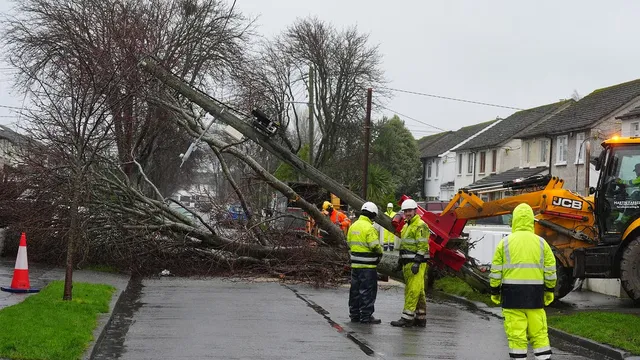
Storm Eowyn devastates UK, leaving millions without power
2025-01-28 11:23- Storm Eowyn struck the UK on January 25, causing historic wind speeds and widespread power outages.
- Emergency services struggled to restore power amidst ongoing storm conditions and multiple fatalities were reported.
- The UK faces continued weather warnings, complicating recovery efforts after the unprecedented impact of the storms.
Express your sentiment!
Insights
The recent storms in the UK have caused significant disruptions and hazards, with Storm Eowyn being a major catalyst for the chaos. Starting from January 25, 2025, hurricane-force winds reached up to 100mph, resulting in widespread flooding, power outages, and damage to infrastructure. Reports indicated that upwards of one million residents were left without electricity, with the situation exacerbated in Scotland where 35,000 properties were still facing blackouts as of January 26, 2025. Emergency services and local governments mobilized, deploying additional engineers to restore power and manage the resulting chaos from the storm. In the aftermath of Storm Eowyn, the UK experienced a new weather front, Storm Herminia, which brought further heavy rain and continued disruptions. Concerns over safety prompted the Environment Agency to issue a series of flood alerts, a total of 31 were reported. The severe weather conditions not only affected power supplies but also caused fatalities, with two teenagers confirmed dead due to falling trees during the tumultuous weather, emphasizing the storm's lethal potential. The fresh weather warnings complicate recovery efforts, especially as emergency services work tirelessly to open roads and restore rail services, heavily impacted by debris and fallen trees. Tragically, Scotland’s transport network faced numerous delays and cancellations due to unsafe travel conditions. The loss of power and disruption to services left residents and businesses in disarray, with many expressing frustration and fear for the safety of their communities. Weather forecasts suggested that instability would persist, with more rain and winds forecasted over the following days, impacting the ongoing efforts to recover from Eowyn and prepare for Herminia. Authorities connected this storm to potential climate changes causing unprecedented weather patterns seen in recent months. As the UK braces for additional heavy rain and powerful winds, the government continues to assess the recovery plans in light of the extensive damages caused by the storms.
Contexts
Climate change is significantly impacting the frequency and intensity of storms in the UK, posing increased risks to both the environment and society. As global temperatures rise due to anthropogenic emissions of greenhouse gases, the atmosphere can hold more moisture, which contributes to the development of more severe weather events, including storms. These changes in storm patterns are critical to understand as they affect infrastructure, ecosystems, and public safety. Recent studies indicate that the UK is experiencing a rise in the number and strength of storms, particularly in the winter months, with attributes such as higher wind speeds and increased rainfall leading to flooding and damage to property. The UK's geographic location makes it particularly susceptible to marine storms that develop over the Atlantic Ocean. Historically, the UK has encountered powerful storms such as Storm Ciara and Storm Dennis, which resulted in widespread flooding and disruption. Climate models suggest that not only will the intensity of such storms increase, but their frequency may also rise, potentially leading to devastating impacts on communities. In coastal areas, rising sea levels due to climate change exacerbate the risk of storm surges, thereby increasing vulnerability to tidal flooding and erosion. As these phenomena become more common, their socio-economic effects will be felt in terms of emergency response costs, insurance claims, and long-term recovery efforts. In response to these challenges, adaptation and mitigation strategies are essential. The UK government and local authorities are investing in better flood defenses, improving early warning systems, and enhancing urban planning to bolster resilience against future storms. Efforts are also being made to address the root causes of climate change by promoting green energy, reducing carbon emissions, and increasing public awareness of climate risks. Such initiatives aim to protect both people and the environment from the adverse effects of increasingly severe storm events. Collaboration among various stakeholders, including governmental agencies, the private sector, and local communities, is necessary to create effective strategies to mitigate these impacts. Furthermore, ongoing research is crucial in understanding the evolving nature of storms in the context of climate change. By accurately modeling future storm patterns, policymakers can make informed decisions that will help safeguard the UK against the increasing threats posed by storms. Additionally, fostering a culture of preparedness can play a vital role in ensuring communities are resilient in the face of natural disasters. It is clear that the implications of climate change on storms in the UK demand urgent and sustained attention to protect lives and livelihoods.